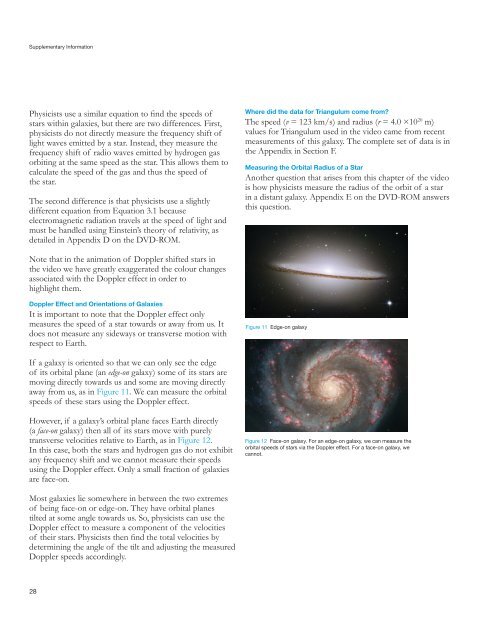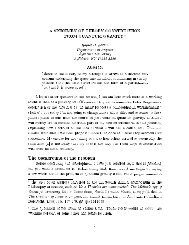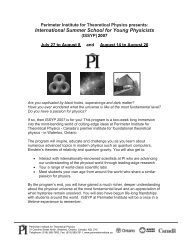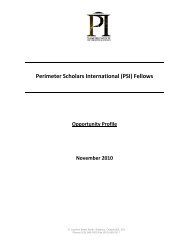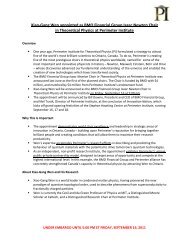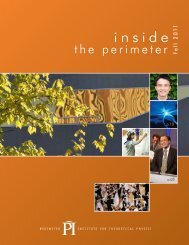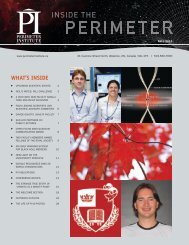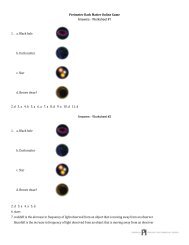Dark Matter Teacher Guide - Perimeter Institute
Dark Matter Teacher Guide - Perimeter Institute
Dark Matter Teacher Guide - Perimeter Institute
Create successful ePaper yourself
Turn your PDF publications into a flip-book with our unique Google optimized e-Paper software.
Supplementary Information<br />
Physicists use a similar equation to find the speeds of<br />
stars within galaxies, but there are two differences. First,<br />
physicists do not directly measure the frequency shift of<br />
light waves emitted by a star. Instead, they measure the<br />
frequency shift of radio waves emitted by hydrogen gas<br />
orbiting at the same speed as the star. This allows them to<br />
calculate the speed of the gas and thus the speed of<br />
the star.<br />
The second difference is that physicists use a slightly<br />
different equation from Equation 3.1 because<br />
electromagnetic radiation travels at the speed of light and<br />
must be handled using Einstein’s theory of relativity, as<br />
detailed in Appendix D on the DVD-ROM.<br />
Note that in the animation of Doppler shifted stars in<br />
the video we have greatly exaggerated the colour changes<br />
associated with the Doppler effect in order to<br />
highlight them.<br />
Doppler Effect and Orientations of Galaxies<br />
It is important to note that the Doppler effect only<br />
measures the speed of a star towards or away from us. It<br />
does not measure any sideways or transverse motion with<br />
respect to Earth.<br />
If a galaxy is oriented so that we can only see the edge<br />
of its orbital plane (an edge-on galaxy) some of its stars are<br />
moving directly towards us and some are moving directly<br />
away from us, as in Figure 11. We can measure the orbital<br />
speeds of these stars using the Doppler effect.<br />
However, if a galaxy’s orbital plane faces Earth directly<br />
(a face-on galaxy) then all of its stars move with purely<br />
transverse velocities relative to Earth, as in Figure 12.<br />
In this case, both the stars and hydrogen gas do not exhibit<br />
any frequency shift and we cannot measure their speeds<br />
using the Doppler effect. Only a small fraction of galaxies<br />
are face-on.<br />
Most galaxies lie somewhere in between the two extremes<br />
of being face-on or edge-on. They have orbital planes<br />
tilted at some angle towards us. So, physicists can use the<br />
Doppler effect to measure a component of the velocities<br />
of their stars. Physicists then find the total velocities by<br />
determining the angle of the tilt and adjusting the measured<br />
Doppler speeds accordingly.<br />
28<br />
Where did the data for Triangulum come from?<br />
The speed (v = 123 km/s) and radius (r = 4.0 ×10 20 m)<br />
values for Triangulum used in the video came from recent<br />
measurements of this galaxy. The complete set of data is in<br />
the Appendix in Section F.<br />
Measuring the Orbital Radius of a Star<br />
Another question that arises from this chapter of the video<br />
is how physicists measure the radius of the orbit of a star<br />
in a distant galaxy. Appendix E on the DVD-ROM answers<br />
this question.<br />
Figure 11 Edge-on galaxy<br />
Figure 12 Face-on galaxy. For an edge-on galaxy, we can measure the<br />
orbital speeds of stars via the Doppler effect. For a face-on galaxy, we<br />
cannot.


